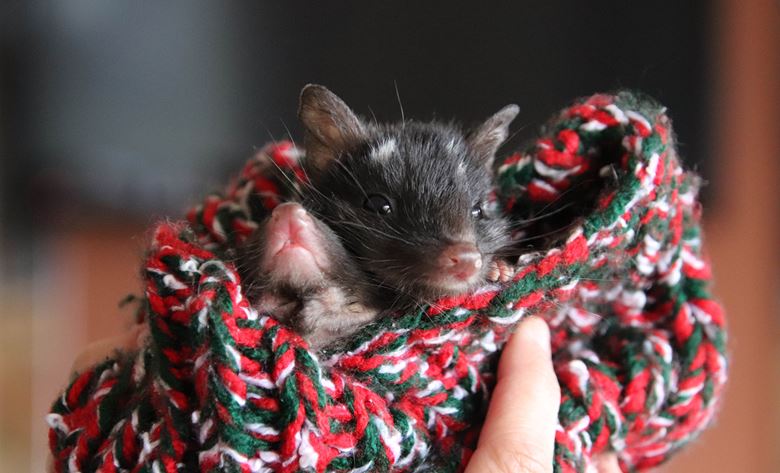Blog
Contact media@wires.org.au for enquiries or call 0416 272 153.
For the latest updates on bushfire recovery projects and emergency response
Read WIRES Emergency Recovery Plan and WIRES National Emergency Response Plan
Visiting Aussie Ark

Eastern Quoll Joeys © WIRES
Many native Australian species were already at risk of extinction, before approximately 3 billion native animals were killed or displaced by the horrific fires of 2019/2020. Empowered by the support of the community WIRES has been working closely with major partners on key projects to support long-term species recovery and conservation.
WIRES have funded some of Aussie Ark's conservation work to help 15 species, including critical programmes to assist Eastern Quolls, Tasmanian Devils, Long-nosed Potoroos and Parma Wallabies.
When WIRES were able to visit Aussie Ark on the 30th September and 1st October 2020, it provided an exceptional opportunity to see the wildlife programmes underway. It was fantastic to see some of their Eastern Quoll and Tasmanian Devil joeys, Long-nosed Potoroos and one of their Parma Wallabies.
With so many species at risk of extinction it is essential to be involved in practical conservation programs to preserve the long-term future of these animals.
Eastern Quolls are endangered, they were once common throughout Australia, but were declared extinct on the mainland in 1963. They now only exist in Tasmania and their numbers in the wild have been declining rapidly. Due to their successful breeding program Aussie Ark now have the largest insurance population of Eastern Quolls on the mainland.

Tasmanian Devil © WIRES
Tasmanian Devils are endangered, they were once found on the mainland but are thought to have become extinct there around 3,000 years ago. One of the biggest threats now facing the conservation of the Tasmanian Devil is Devil Facial Tumour Disease (DFTD), an infectious cancer that only affects Tasmanian devils. It was first detected in 1996 and since then 90% of the wild population has been lost.

Long-nosed Potoroo © WIRES
Long-nosed Potoroos are listed as vulnerable to extinction, with only isolated populations still found in Victoria, New South Wales and South-Eastern Queensland.

Parma Wallaby © WIRES
Parma Wallabies are listed as vulnerable to extinction in NSW and they are now only found in areas of the Great Dividing Range.
Australia has such rich biodiversity and so many species found nowhere else in the world. Through collaboration on projects to protect wildlife long-term, WIRES and Aussie Ark believe it is possible to secure the future of these species for generations to come.
For those interested in visiting Aussie Ark, you can review the options on Aussie Ark's site, and the NSW tour available through AEA Luxury Tours. AEA are supporting wildlife conservation with Aussie Ark via their tours, and donating $10 to WIRES to help support wildlife rescue, for each person that books their 3 day weekend with the devils programme.
#tasmaniandevils #easternquolls
#longnosedpotoroos #parmawallabies #wildlife #conservation
#wildlifeconservation #aussieark #aealuxury #aealuxurytours
Search
Newsletter
Stay in touch and get our regular rescue stories, WIRES updates and a free copy of our 15 Ways to Help Wildlife ebook
Recent Posts
- Emergency Response Training for Wildlife Volunteers
- WIRES Introduces New Wildlife Rehabilitation Governance Courses in Collaboration with NPWS
- Community Support for Post-Bushfire Recovery of Wildlife in the Greater Blue Mountains
- Research Grants Program-2023 Recipients Announced
- National Koala Conference
- Nature Conservation Council's Bushfire Conference
- Support Stronger Nature Laws
- Helping Endangered Cockatoos: WIRES Grant Success Story
- Landmark Conservation Project Ensures The Future of The Northern Bettong
- Wildlife Road Collisions Unveiled
